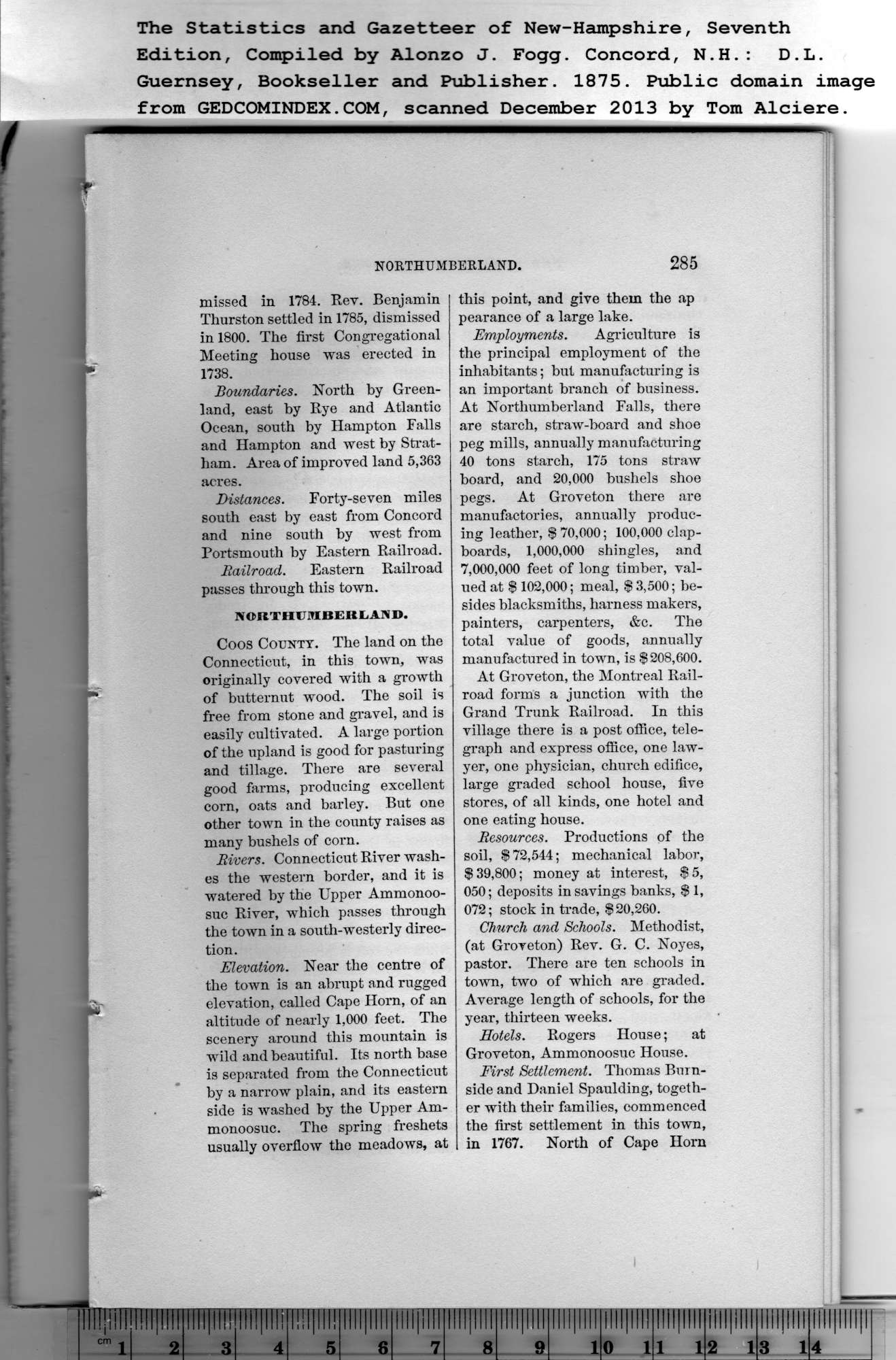|
missed in 1784. Rev. Benjamin
Thurston settled in 1785, dismissed
in 1800. The first Congregational
Meeting house was erected in
1738.
Boundaries. North by Green-
land, east by Rye and Atlantic
Ocean, south by Hampton Falls
and Hampton and west by Strat-
ham. Area of improved land 5,363
acres.
Distances. Forty-seven miles
south east by east from Concord
and nine south by west from
Portsmouth by Eastern Railroad.
Railroad. Eastern Railroad
passes through this town.
NORTHUMBERLAND.
Coos County. The land on the
Connecticut, in this town, was
originally covered with a growth
of butternut wood. The soil is
free from stone and gravel, and is
easily cultivated. A large portion
of the upland is good for pasturing
and tillage. There are several
good farms, producing excellent
corn, oats and barley. But one
other town in the county raises as
many bushels of corn.
Rivers. Connecticut River wash-
es the western border, and it is
watered by the Upper Ammonoo-
suc River, which passes through
the town in a south-westerly direc-
tion.
Elevation. Near the centre of
the toAvn is an abrupt and rugged
elevation, called Cape Horn, of an
altitude of nearly 1,000 feet. The
scenery around this mountain is
wild and beautiful. Its north base
is separated from the Connecticut
by a narrow plain, and its eastern
side is washed by the Upper Am-
monoosuc. The spring freshets
usually overflow the meadows, at
this point, and give them the ap
pearance of a large lake. |
Employments. Agriculture is
the principal employment of the
inhabitants; but manufacturing is
an important branch of business.
At Northumberland Falls, there
are starch, straw-board and shoe
peg mills, annually manufacturing
40 tons starch, 175 tons straw
board, and 20,000 bushels shoe
pegs. At Groveton there are
manufactories, annually produc-
ing leather, $ 70,000; 100,000 clap-
boards, 1,000,000 shingles, and
7,000,000 feet of long timber, val-
ued at $ 102,000; meal, $ 3,500; be-
sides blacksmiths, harness makers,
painters, carpenters, &c. The
total value of goods, annually
manufactured in town, is $208,600.
At Groveton, the Montreal Rail-
road forms a junction with the
Grand Trunk Railroad. In this
village there is a post office, tele-
graph and express office, one law-
yer, one physician, church edifice,
large graded school house, five
stores, of all kinds, one hotel and
one eating house.
Resources. Productions of the
soil, $72,544; mechanical labor,
$ 39,800; money at interest, $ 5,
050; deposits in savings hanks, $ 1,
072; stock in trade, $ 20,260.
Church and Schools. Methodist,
(at Groveton) Rev. G. C. Noyes,
pastor. There are ten schools in
town, two of which are graded.
Average length of schools, for the
year, thirteen weeks.
Hotels. Rogers House; at
Groveton, Ammonoosuc House.
First Settlement. Thomas Burn-
side and Daniel Spaulding, togeth-
er with their families, commenced
the first settlement in this town,
in 1767. North of Cape Horn |
